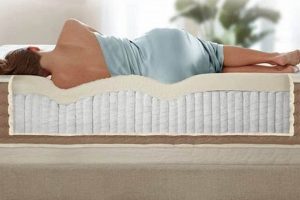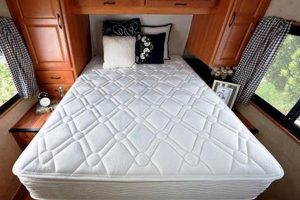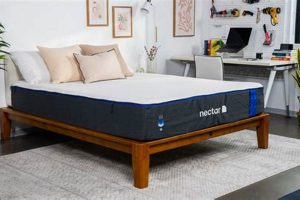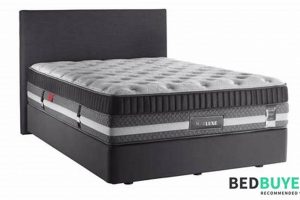The selection of an appropriate sleep surface for powered, articulating bed frames is a crucial consideration for optimizing comfort and support. These specialized mattresses are designed to conform to the various positions achievable by the adjustable base, ensuring consistent spinal alignment and pressure relief throughout the range of motion. For example, a mattress that is too rigid may not bend properly, while one that lacks sufficient support could sag or develop indentations over time.
The significance of a compatible mattress extends beyond mere comfort. Properly selected mattresses can improve circulation, alleviate pressure points, and enhance the overall sleep experience. Historically, individuals with mobility issues, chronic pain, or respiratory conditions have found adjustable beds and corresponding mattresses to be particularly beneficial in managing symptoms and promoting restful sleep. The right pairing offers a tailored sleep solution that addresses individual needs and preferences.
Therefore, a comprehensive exploration of mattress types, construction materials, and key features relevant to adjustable bed compatibility is warranted. Subsequent sections will delve into these aspects, providing guidance for informed decision-making regarding mattress selection for adjustable bed frames.
Optimizing Adjustable Bed Mattress Selection
The following guidelines are designed to assist in the selection of a mattress specifically for use with an adjustable bed frame. Adherence to these recommendations can contribute to enhanced comfort, durability, and functionality.
Tip 1: Prioritize Flexibility: Mattresses must exhibit sufficient flexibility to conform to the adjustable base’s various positions without compromising structural integrity. Memory foam, latex, and hybrid models are generally well-suited for this purpose due to their inherent pliability.
Tip 2: Consider Mattress Thickness: While personal preference plays a role, excessively thick mattresses may hinder the adjustable bed’s articulation, potentially reducing the range of motion. Conversely, overly thin mattresses might lack adequate support.
Tip 3: Evaluate Edge Support: Reinforced edge support is crucial to prevent sagging and maintain stability when the mattress is in an elevated position. This feature extends the usable sleep surface and enhances overall comfort.
Tip 4: Assess Weight Capacity: Confirm that the selected mattress is compatible with the adjustable bed frame’s weight capacity to avoid potential damage or malfunction. Consider the combined weight of the occupants and the mattress itself.
Tip 5: Verify Compatibility with Bed Frame Type: Some adjustable bed frames have specific mattress requirements or limitations. Consult the manufacturer’s specifications to ensure compatibility and optimal performance.
Tip 6: Inquire About Warranty Coverage: Review the mattress warranty terms and conditions to determine coverage for use with an adjustable bed frame. Some warranties may be voided if the mattress is not used in accordance with the manufacturer’s recommendations.
Tip 7: Inspect Mattress Construction: Mattresses designed for adjustable beds often incorporate specialized features, such as segmented construction or flexible hinges, to enhance their ability to conform to the bed’s contours. Look for these features to maximize performance.
Careful attention to these factors can result in a more comfortable and supportive sleep environment, fully leveraging the benefits of an adjustable bed system. The subsequent conclusion will summarize the critical aspects of mattress selection.
The following section will summarize the key considerations discussed and offer concluding remarks regarding the selection process.
1. Flexibility
Flexibility represents a primary characteristic when determining the suitability of a mattress for use with an adjustable bed frame. It dictates the mattress’s capacity to conform to the various positions the adjustable base can achieve without compromising comfort or structural integrity.
- Conformability to Bed Positions
A mattress with high flexibility can readily adapt to the inclines and contours of an adjustable bed, ensuring consistent support and pressure relief regardless of the selected position. Conversely, a rigid mattress may resist bending, creating uncomfortable pressure points and diminishing the benefits of the adjustable base. Examples include individuals using the zero-gravity position for back pain relief, which requires the mattress to smoothly contour to the raised head and leg sections.
- Material Stress and Durability
Inadequate flexibility can lead to increased stress on the mattress materials, particularly at points of flexion. This can result in premature wear and tear, including cracking, sagging, or deformation of the mattress core. Mattresses constructed from materials inherently lacking in flexibility, such as traditional innerspring systems without adequate conforming layers, are more susceptible to this type of damage when paired with adjustable beds. The implications involve reduced lifespan and potential voiding of warranty coverage.
- Consistent Support and Spinal Alignment
Flexibility directly influences the mattress’s ability to maintain proper spinal alignment throughout the adjustable bed’s range of motion. A mattress that conforms well supports the natural curvature of the spine in various positions, minimizing strain on muscles and joints. Lack of flexibility can lead to uneven support and potential misalignment, exacerbating back pain or discomfort. Consider the scenario of someone sleeping in a reclined position; the mattress must flex to support the lumbar region effectively.
- Compatibility with Mattress Construction
The internal construction of the mattress plays a significant role in its overall flexibility. Mattresses with segmented core designs or strategically placed flex points are often better suited for adjustable beds. These design features enhance the mattress’s ability to bend and conform to the base without compromising support. Materials like memory foam and latex generally exhibit superior flexibility compared to traditional innerspring systems, making them popular choices for adjustable beds.
Ultimately, flexibility is not merely a desirable trait, but a functional necessity for mattresses intended for use with adjustable bed frames. It underpins the mattress’s ability to deliver consistent support, maintain structural integrity, and maximize the benefits of the adjustable base. Therefore, careful evaluation of a mattress’s flexibility is paramount in the selection process.
2. Thickness
Mattress thickness significantly influences the performance and suitability of a
mattress designed for adjustable beds. The correlation is intricate, impacting both the bed frame’s functionality and the user’s comfort. An inappropriate thickness can impede the adjustable base’s articulation, while also failing to provide adequate support.
Thickness influences the degree to which a mattress conforms to the adjustable bed’s positions. An excessively thick mattress might resist bending, thereby limiting the range of motion. This resistance can lead to discomfort, particularly at pressure points, as the sleep surface struggles to align with the body’s contours in the adjusted position. Conversely, a mattress that is too thin may not offer sufficient cushioning or support, resulting in an inadequate sleep experience. For instance, a very thin memory foam mattress might bottom out on the base, providing little pressure relief.
Optimal thickness is determined by a balance between support, flexibility, and the adjustable base’s design. Most adjustable bed manufacturers recommend a mattress thickness within a specific range, typically between 10 and 14 inches. Exceeding this range could strain the lifting mechanisms or interfere with the bed’s ability to achieve its full range of positions. Ultimately, mattress thickness is a pivotal factor in realizing the intended benefits of an adjustable bed system, necessitating careful consideration to ensure both comfort and functionality.
3. Edge Support
Edge support, referring to the reinforcement of a mattress’s perimeter, is a critical component when evaluating mattresses specifically for adjustable beds. The stability of the mattress edges directly influences the usable sleep surface, particularly when the bed is in an elevated or inclined position. Weak edge support can lead to sagging or compression along the perimeter, diminishing the overall comfort and stability of the sleep surface. This effect is exacerbated when the adjustable bed is in use, as the pressure distribution changes and concentrates weight towards certain areas of the mattress. For example, an individual sitting on the edge of the bed while it is raised may experience significant compression if the edge support is inadequate.
The implementation of robust edge support in mattresses for adjustable beds serves several practical purposes. It enhances the accessibility of the bed, allowing individuals to easily get in and out, even when the bed is inclined. It also increases the longevity of the mattress by preventing premature wear along the edges, which are often subjected to concentrated pressure. Furthermore, sufficient edge support contributes to a more consistent sleep surface, minimizing the feeling of rolling off the bed. This is especially important for individuals who require the adjustable bed to manage medical conditions, as a stable and supportive surface is essential for maximizing therapeutic benefits. Manufacturers often employ techniques such as reinforced coils, high-density foam encasements, or specialized edge support systems to address this need.
In summary, effective edge support is an indispensable characteristic for mattresses designed for adjustable beds. Its presence not only enhances the comfort and usability of the mattress but also contributes to its long-term durability and the overall effectiveness of the adjustable bed system. Therefore, careful consideration of edge support is warranted when selecting a mattress for an adjustable bed frame to ensure optimal performance and user satisfaction. The presence of robust edge support translates to a more reliable, supportive, and comfortable sleep environment, particularly when the adjustable bed is in various elevated positions.
4. Material Composition
The material composition of a mattress directly dictates its suitability for adjustable bed frames, influencing flexibility, support, and longevity. Mattresses designed for adjustable beds must possess the capacity to conform to various angles and positions without compromising structural integrity or comfort. The inherent properties of the materials used are therefore paramount. For instance, memory foam, known for its viscoelasticity, readily adapts to the contours of an adjustable bed, providing pressure relief and maintaining consistent support as the bed articulates. Latex, another commonly used material, offers a balance of responsiveness and contouring, also exhibiting the required flexibility. In contrast, traditional innerspring mattresses, while potentially suitable, may offer limited conformity unless combined with substantial comfort layers of memory foam or latex. The choice of materials significantly impacts the user experience and the durability of the mattress when used with an adjustable bed.
Beyond flexibility, material composition affects the overall support characteristics of the mattress. High-density foams, whether memory foam or latex, provide consistent support and minimize motion transfer, both of which are crucial for a comfortable sleep experience on an adjustable bed. The composition also influences temperature regulation. Certain materials, such as open-cell memory foam or latex with ventilation channels, promote airflow and dissipate heat, preventing overheating. Inversely, some traditional memory foams can retain heat, potentially leading to discomfort. Therefore, the selection of materials must consider factors beyond flexibility and support to ensure a comfortable and conducive sleep environment. A practical example involves individuals with back pain who benefit from the conforming properties of memory foam on an adjustable bed, allowing them to find a position that alleviates pressure on their spine.
Ultimately, the material composition is an indispensable factor when choosing a mattress for an adjustable bed. It affects flexibility, support, temperature regulation, and durability, all of which contribute to the overall performance and user satisfaction. Ignoring material properties can result in discomfort, premature wear, or even damage to the adjustable bed frame. Therefore, prospective buyers should prioritize mattresses constructed from materials specifically designed to withstand the demands of an adjustable bed, ensuring a seamless and comfortable sleep experience. The material composition selection represents a crucial decision, directly impacting the long-term performance and benefits derived from the adjustable bed system.
5. Weight Capacity
The weight capacity of both the adjustable bed frame and the selected mattress is a critical factor in determining overall system performance and longevity. Exceeding the specified weight limit of either component can lead to structural damage, operational failure, and a compromised sleep experience. Therefore, assessing weight capacity is not merely a technical consideration but a fundamental aspect of selecting an appropriate mattress for an adjustable bed. For instance, a mattress exceeding the frame’s capacity can strain the lifting mechanisms, resulting in premature wear or even complete failure. Conversely, a mattress incapable of adequately supporting the intended load may exhibit sagging or compression, diminishing its ability to provide proper spinal alignment and pressure relief.
Weight capacity considerations extend beyond the static weight of the mattress and occupants.
The dynamic forces generated during movement and positional adjustments of the bed frame must also be accounted for. A mattress with insufficient density or structural integrity may deform or degrade more rapidly under these dynamic loads, reducing its lifespan. Furthermore, exceeding weight limits can void warranty coverage for both the mattress and the adjustable bed frame, potentially resulting in significant financial burden for repairs or replacements. Individuals considering an adjustable bed should meticulously review the weight specifications provided by the manufacturers of both the frame and the mattress, ensuring a comfortable safety margin to accommodate all potential users and bedding accessories.
In conclusion, a thorough understanding of weight capacity limitations is paramount in selecting the most suitable mattress for an adjustable bed. This consideration directly impacts the system’s durability, performance, and safety, underscoring its importance in achieving the desired benefits of adjustability and personalized comfort. Neglecting weight capacity assessments can lead to costly repairs, compromised sleep quality, and a shortened lifespan for both the mattress and the adjustable bed frame. Therefore, prioritize accurate weight assessments to ensure long-term satisfaction and optimal system performance.
6. Motion Isolation
Motion isolation, referring to a mattress’s capacity to minimize the transfer of movement across its surface, assumes heightened importance in the context of adjustable beds, particularly for couples. The independent articulation of adjustable beds can inadvertently amplify motion transfer if the mattress lacks adequate isolation properties. For example, the raising or lowering of one side of the bed could generate movement on the other side, potentially disturbing a sleeping partner. This necessitates that mattresses designed for adjustable beds possess superior motion isolation characteristics to ensure uninterrupted sleep for both individuals.
The selection of materials and construction methods directly influences a mattress’s motion isolation capabilities. Memory foam and latex mattresses, due to their inherent damping properties, typically excel at minimizing motion transfer compared to traditional innerspring models. Hybrid mattresses, incorporating a combination of foam layers and pocketed coils, can also provide effective motion isolation by isolating the movement of individual coils. The practical implications of effective motion isolation extend beyond simply preventing disturbances; it also contributes to a more comfortable and supportive sleep environment by reducing pressure points and promoting spinal alignment.
In summary, motion isolation is a crucial attribute for mattresses intended for use with adjustable beds, particularly in shared sleeping arrangements. The selection of materials and construction techniques should prioritize motion isolation to minimize partner disturbance and enhance overall sleep quality. This aspect directly contributes to the perceived quality and effectiveness of the adjustable bed system, reinforcing its importance in achieving optimal sleep outcomes.
7. Breathability
Breathability, pertaining to a mattress’s capacity to dissipate heat and moisture, represents a crucial factor in determining sleep comfort, particularly in the context of adjustable beds. The enclosed nature of many adjustable bed frames, coupled with the conforming properties of mattresses often recommended for them, can impede airflow, potentially leading to heat retention and discomfort. Therefore, breathability is not merely a desirable attribute, but a functional necessity for mattresses used with adjustable beds.
- Material Composition and Airflow
The constituent materials of a mattress significantly influence its breathability. Open-cell foam structures, such as those found in certain memory foam and latex formulations, promote airflow, allowing heat and moisture to escape more readily than closed-cell alternatives. Natural fibers, like cotton or wool, incorporated into the mattress cover can further enhance breathability by wicking away moisture. In contrast, dense, synthetic materials may restrict airflow, leading to heat buildup. The material selection directly impacts the mattress’s ability to regulate temperature and maintain a comfortable sleep environment.
- Construction Techniques and Ventilation
Mattress construction techniques can either enhance or impede breathability. Strategically placed ventilation channels or perforations within the foam layers can create pathways for air circulation, facilitating heat dissipation. Hybrid mattresses, combining foam layers with a coil support system, often exhibit superior breathability due to the inherent airflow within the coil structure. The construction approach dictates the overall ventilation efficiency of the mattress and its capacity to prevent heat retention.
- Adjustable Bed Frame Design and Air Circulation
The design of the adjustable bed frame itself can also influence mattress breathability. Frames with solid platforms may restrict airflow beneath the mattress, while those with slatted or open designs promote ventilation. The degree to which the frame allows for air circulation beneath the mattress can either exacerbate or mitigate potential heat retention issues. The frame’s architecture plays a supporting role in maintaining a comfortable sleep temperature.
- Impact on Sleep Quality and Comfort
Insufficient breathability can lead to elevated sleep surface temperatures, resulting in discomfort, restlessness, and disrupted sleep patterns. The accumulation of moisture within the mattress can also create an environment conducive to microbial growth and allergen accumulation, potentially affecting respiratory health. Adequate breathability promotes a cooler, drier sleep environment, enhancing sleep quality and overall comfort. It is especially relevant for individuals prone to night sweats or residing in warmer climates.
The interplay of material composition, construction techniques, and adjustable bed frame design collectively determines the breathability of a mattress. Prioritizing breathability is crucial in selecting a mattress for an adjustable bed, ensuring a comfortable and hygienic sleep environment. Insufficient attention to this factor can negate other benefits of the adjustable bed system, highlighting its importance in the overall selection process. Examples include the selection of cooling gel infused memory foam to mitigate heat retention from the articulating base. It can either disrupt or improve sleep quality.
Frequently Asked Questions
The following section addresses common inquiries regarding mattress selection for adjustable bed frames. The information provided aims to clarify misconceptions and offer guidance for informed decision-making.
Question 1: Are specific mattress types inherently incompatible with adjustable beds?
While most modern mattresses can function with adjustable beds, traditional innerspring mattresses with limited flexibility are generally less suitable. Memory foam, latex, and hybrid models typically exhibit superior conformity and durability when used with adjustable bases.
Question 2: Does mattress thickness impact the performance of an adjustable bed?
Yes, excessively thick matt
resses may hinder the adjustable bed’s articulation, reducing the range of motion. Conversely, overly thin mattresses might lack adequate support. Manufacturers typically recommend a specific thickness range for optimal performance.
Question 3: Is edge support a critical feature for adjustable bed mattresses?
Reinforced edge support is crucial to prevent sagging and maintain stability when the mattress is in an elevated position. This feature extends the usable sleep surface and enhances overall comfort.
Question 4: Can exceeding the weight capacity of an adjustable bed damage the mattress?
Exceeding the weight capacity of either the adjustable bed frame or the mattress can lead to structural damage and premature wear. Adhering to the manufacturer’s weight specifications is essential for both safety and longevity.
Question 5: Does motion isolation matter in adjustable bed mattresses, especially for couples?
Motion isolation is particularly important for couples using adjustable beds. The independent articulation of the bed can amplify motion transfer, necessitating mattresses with superior motion isolation properties.
Question 6: How important is breathability in mattresses designed for adjustable beds?
Breathability is crucial to prevent heat retention and promote a comfortable sleep environment. Materials and construction techniques that enhance airflow are particularly beneficial, given the potential for reduced ventilation with adjustable bed frames.
Proper selection of a mattress for an adjustable bed requires careful consideration of mattress type, thickness, edge support, weight capacity, motion isolation, and breathability. These factors contribute to both comfort and the overall performance of the adjustable bed system.
The subsequent section will provide a summary of the key considerations discussed and offer concluding remarks.
Conclusion
The preceding discussion has elucidated the multifaceted considerations involved in selecting the optimal mattress for adjustable bed frames. Key factors such as flexibility, thickness, edge support, material composition, weight capacity, motion isolation, and breathability have been identified as critical determinants of both comfort and system performance. The interplay between these elements dictates the overall suitability of a mattress for use with an adjustable base, influencing user satisfaction and the longevity of the investment.
The integration of this information into the decision-making process is paramount. The appropriate pairing of a mattress with an adjustable bed frame represents a significant investment in sleep quality and overall well-being. Continued advancements in mattress technology and adjustable bed design suggest an evolving landscape, necessitating ongoing evaluation of available options to ensure sustained comfort and support.



![Top-Rated: Best Twin Size Air Mattress [Guide] Organic & Natural Mattress Buyer’s Guide: Non-Toxic Sleep Solutions Top-Rated: Best Twin Size Air Mattress [Guide] | Organic & Natural Mattress Buyer’s Guide: Non-Toxic Sleep Solutions](https://mattressworldpa.com/wp-content/uploads/2025/07/th-7636-300x200.jpg)


![Top-Rated: Choosing the Best Mattress Foundation [Guide] Organic & Natural Mattress Buyer’s Guide: Non-Toxic Sleep Solutions Top-Rated: Choosing the Best Mattress Foundation [Guide] | Organic & Natural Mattress Buyer’s Guide: Non-Toxic Sleep Solutions](https://mattressworldpa.com/wp-content/uploads/2025/07/th-7633-300x200.jpg)
